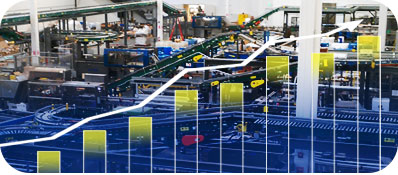Did your plant achieve its efficiency goals in 2014? The new year is a good time to assess your production and sales benchmarks from the previous year and to identify areas for improvement. Budget now for capital improvements and technology investments than can help your company meet or exceed its goals. 
Technology
The good news for food and beverage manufacturers is that 2015 and the coming years will bring new technology that can have a real impact on workflow, production efficiency, and energy efficiency. Experts point to the evolution of big data and the promise of the Internet of Things (IoT) as two innovations that will impact manufacturing.
In a report on manufacturing trends for 2015, John Zegers wrote, “Sensor technologies will drive the concept of connected factories and will fuel the introduction of mobility-based manufacturing. Web browsers will be used as dashboards to control equipment, identify snags and make quick decisions that would have previously taken entire teams of people to handle.”
Zegers, a manufacturing innovation specialist, counsels that food manufacturers can make use of new software and sensors to collect and use data more effectively to make system changes.
Upgraded and flexible systems
Zegers also predicts that 2015 will bring profit increases that allow food producers to invest in new, more efficient equipment, writing, “Improved bottom lines will drive replacement of aging legacy equipment and investment in new capital equipment that performs better, more efficiently and more reliably. Software will also assist in making current equipment more efficient.”
This example illustrates his point well. The Ohio Campbell’s Soup production facility profiled in the article has been in operation since 1938. It has undergone five expansions and decades of changes, including the addition of many new products and SKUs that must be processed. Recent design and equipment upgrades have led to “…better yield, faster clean-up and changeovers, and more consistent quality” for the company.
Modern food processing equipment is often designed in modules with the need for flexibility in mind. Many food manufacturers produce multiple product lines, and a plant design that allows for quick changeovers increases the overall efficiency of the manufacturing process. In this whitepaper, Food Processing magazine covers several considerations that go into designing a flexible food plant that operates more nimbly to meet consumers’ needs.
“Equipment manufacturers continue to offer new models designed for clean-in-place, quick connect and disconnect and mobility. One of the challenges for the A&E firms is to design plants where movement is easy, and where components can be stored out of the way and kept in ready-condition,” writes David Phillips in the whitepaper.
WPS offers the design and engineering expertise food manufacturers need to do just that. We approach each project with a food or beverage company’s unique processing needs in mind, and we design custom plans to optimize your operations.
Energy efficiency
Food plants can increase their bottom lines by reducing the cost of the energy used for operations. With recent attention on LEED certification and large-scale sustainability efforts, one might assume that becoming more energy efficient requires a huge capital investment, but Christina Chatfield reminds us in the Manufacturing Innovation Blog that, “the low-hanging fruit in energy savings is often quite mundane and relatively easy to implement. Simply turning equipment off when not in use can save huge amounts of energy. Fixing leaks, air-sealing buildings, and switching to energy efficient lighting are also excellent ways to reduce energy use and save money.”
Quality design and engineering
At WPS, we specialize in helping food and beverage producers create optimal workflow and efficient systems with Custom Process Design, for new plants or those undergoing an overhaul, and Continuous Process Improvement services that can help improve efficiency in small-scale and large-scale projects alike. We can help assess, upgrade and optimize your current systems or design and build completely new production lines or facilities.

